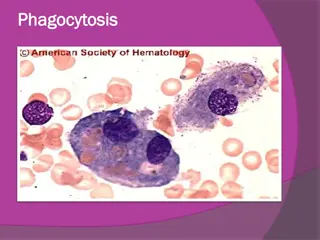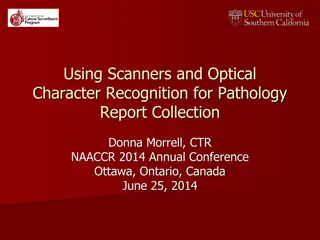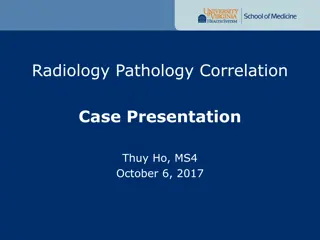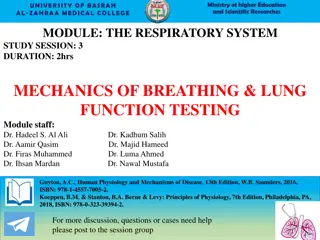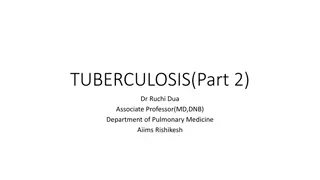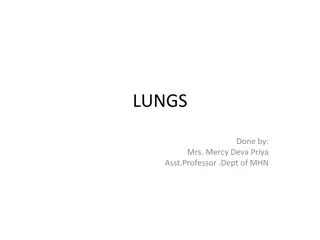Understanding Tuberculosis and Lung Cancer in Respiratory Pathology at KSU
Explore the detailed pathology of Tuberculosis (TB) and Lung Cancer through images and descriptions prepared by experts at the Pathology Department of King Saud University (KSU). Discover the features of TB such as epithelioid and giant cell granulomas, Ghon's complex, caseous necrosis, miliary TB, and more. Dive into the gross pathology of pulmonary TB, its complications, and understand the differences between primary and secondary TB. Enhance your knowledge of respiratory diseases with this insightful visual material.
Download Presentation

Please find below an Image/Link to download the presentation.
The content on the website is provided AS IS for your information and personal use only. It may not be sold, licensed, or shared on other websites without obtaining consent from the author. Download presentation by click this link. If you encounter any issues during the download, it is possible that the publisher has removed the file from their server.
E N D
Presentation Transcript
Prof. Ammar Al Rikabi Dr. Sayed Al Esawy Dr. Marie Mukhashin Dr. Shaesta Zaidi Prepared by: Head of Pathology Department: Dr. Hisham Al Khalidi
SECOND PRACTICAL 1. TUBERCULOSIS 2. CANCER OF THE LUNG Respiratory Block Pathology Dept. KSU
Epithelioid and giant cell Granuloma, Ghons complex or caseation is present Complications of TB are: - Amyloidosis , - Tuberculous pneumonia - Miliary tuberculosis - Tuberculous meningitis - Addison disease . Respiratory Block Pathology Dept. KSU
Pulmonary TB - Ghons Complex Gross Pathology The Ghon s complex is seen here at closer range. Primary tuberculosis is the pattern seen with initial infection with tuberculosis in children. Reactivation, or secondary tuberculosis, is more typically seen in adults. Respiratory Block Pathology Dept. KSU
Pulmonary TB Caseous Necrosis Gross Extensive caseation and the granulomas involve a larger bronchus causing soft, necrotic center to drain out and leave behind a cavity. Cavitation is typical for large granulomas with TB. Cavitation is more common in the upper lobes. Respiratory Block Pathology Dept. KSU
Pulmonary TB Caseous Necrosis Gross On closer inspection, the granulomas have areas of caseous necrosis. This pattern of multiple caseating granulomas primarily in the upper lobes is most characteristic of secondary (reactivation) tuberculosis Respiratory Block Pathology Dept. KSU
Miliary TB of the Lungs Miliary TB can occur when TB lung lesions erode pulmonary veins or when extrapulmonary TB lesions erode systemic veins. This results in hematogenous dissemination of tubercle bacilli producing myriads of 1- 2 mm. lesions throughout the body in susceptible hosts. Miliary spread limited to the lungs, The route by which the organisms have spread: following erosion of pulmonary arteries by TB lung lesions. Respiratory Block Pathology Dept. KSU
Miliary TB of the Lungs Cut section This is a "miliary" pattern of granulomas because there are a multitude of small tan granulomas, about 2 to 4 mm in size, scattered throughout the lung parenchyma. The miliary pattern gets its name from the resemblence of the granulomas to millet seeds. Respiratory Block Pathology Dept. KSU
Miliary TB of the Lungs X-Ray This chest x-ray shows a patient with miliary TB showing miliary nodules and Reticular shadows.. Respiratory Block Pathology Dept. KSU
Tuberculous Granulomas - HPF Well-defined granulomas are seen here. They have rounded outlines. The one toward the center of the photograph contains several Langhan s giant cells. Granulomas are composed of transformed macrophages called epithelioid cells along with lymphocytes, occasional PMN's, plasma cells, and fibroblasts Respiratory Block Pathology Dept. KSU
Pulmonary TB - Granuloma with central early necrosis Giant cells and epithelioid histiocytic granulomas with caseous necrosis Respiratory Block Pathology Dept. KSU
Tuberculous Granulomas - HPF 1 2 The edge of a granuloma is shown here at high magnification. At the upper is amorphous pink caseous material [1] composed of the necrotic elements of the granuloma as well as the infectious organisms. This area is ringed by the inflammatory component [2] with epithelioid cells, lymphocytes, and fibroblasts. Respiratory Block Pathology Dept. KSU
Epithelioid & Giant cell Granulomas in Tuberculosis At high magnification, the granuloma demonstrates that the epithelioid macrophages are elongated with long, pale nuclei and pink cytoplasm. The macrophages organize into committees called giant cells. The typical giant cell for infectious granulomas is called a Langhan s giant cell and has the nuclei lined up along one edge of the cell Respiratory Block Pathology Dept. KSU
Acid Fast bacilli of Mycobacterium TB in the Lung A stain for Acid Fast Bacilli is done (AFB stain) to find the mycobacteria . The mycobacteria stain as red rods, as seen here at high magnification. Respiratory Block Pathology Dept. KSU
LUNG CARCINOMA Respiratory Block Pathology Dept. KSU
TWO TYPES OF LUNG CARCINOMA NON-SMALL CELL CARCINOMA SQUAMOUS CELL CARCINOMA ADENOCARCINOMA LARGE CELL CARCINOMA 1. 2. 3. SMALL CELL CARCINOMA The NON-small cell cancers behave and are treated similarly, the SMALL cell carcinomas are WORSE than the non-small cell carcinomas, but respond better to chemotherapy, often drastically! Respiratory Block Pathology Dept. KSU
1. Squamous Cell Carcinoma of the lung Most commonly found in men and correlated with smoking. Respiratory Block Pathology Dept. KSU
Squamous Cell Carcinoma of the Lung - Gross This is a squamous cell carcinoma of the lung that is arising centrally in the lung (as most squamous cell carcinomas do). It is obstructing the right main bronchus. The neoplasm is very firm and has a pale white to tan cut surface. Respiratory Block Pathology Dept. KSU
Squamous Cell Carcinoma of the Lung - Gross This is a larger squamous cell carcinoma in which a portion of the tumor demonstrates central cavitation, probably because the tumor outgrew its blood supply. Respiratory Block Pathology Dept. KSU
Squamous Cell Carcinoma of the Lung CT scan This chest CT scan view demonstrates a large squamous cell carcinoma of the right upper lobe that extends around the right main bronchus and also invades into the mediastinum and involves hilar lymph nodes. Respiratory Block Pathology Dept. KSU
Squamous Cell Carcinoma of the Lung - HPF Microscopic appearance of squamous cell carcinoma with nests of polygonal cells with pink cytoplasm and distinct cell borders. The nuclei are hyperchromatic and angular. Pathology Dept. KSU Respiratory Block
Squamous Cell Carcinoma of the Lung - HPF R L In this squamous cell carcinoma at the upper right is a squamous eddy with a keratin pearl. At the left, the tumor is less differentiated and several dark mitotic figures are seen Pathology Dept. KSU Respiratory Block
Squamous Cell Carcinoma of the Lung - HPF The pink cytoplasm with distinct cell borders and intercellular bridges characteristic for a squamous cell carcinoma of the lung Respiratory Block Pathology Dept. KSU
2. Adenocarcinoma of the lung The most common type of lung cancer, making up 30-40% of all cases. Glandular differentiation by tumor cells and 80% of those cells produce mucin. Not as strongly associated with a smoking history as compared to Squamous or Small Cell Carcinomas Respiratory Block Pathology Dept. KSU
Adenocarcinoma of the Lung Gross A peripheral adenocarcinoma of the lung. Adenocarcinomas and large cell anaplastic carcinomas tend to occur more peripherally in lung. Adenocarcinoma is the one cell type of primary lung tumor that occurs more often in non-smokers and in smokers who have quit. Respiratory Block Pathology Dept. KSU
Adenocarcinoma of the Lung CT scan X-Ray A peripheral adenocarcinoma of the lung appears in this chest radiograph of an elderly non-smoker woman. CT scans in a 61-year-old man with adenocarcinoma of the lung Respiratory Block Pathology Dept. KSU
Adenocarcinoma of the Lung LPF Microscopically, the Adenocarcinoma in Situ ( Previously named Bronchioloalveolar Carcinoma) is composed of columnar cells that proliferate along the framework of alveolar septae. The cells are well-differentiated. Respiratory Block Pathology Dept. KSU
Adenocarcinoma of the Lung HPF Section of the tumor shows moderately differentiated malignant glands lined by pleomorphic and hyperchromatic malignant cells showing conspicuous nucleoli . Note the presence of tissue desmoplasia around the neoplastic glands . Respiratory Block Pathology Dept. KSU
Adenocarcinoma of the Lung HPF Differentiated malignant glands lined by pleomorphic and hyperchromatic malignant cells showing conspicuous nucleoli Pathology Dept. KSU Respiratory Block
3. Large Cell Carcinoma of the lung Can be a neuroendocrine carcinoma. Probably represents undifferentiated SCC and adenocarcinomas. Large nuclei, prominent nucleoli. Variation in size and shape. Nuclei normally do not touch due to more cytoplasm. Moderate amount of cytoplasm. Respiratory Block Pathology Dept. KSU
Large Cell Carcinoma of the Lung Gross Respiratory Block Pathology Dept. KSU
Undifferentiated Large Cell Carcinoma of the Lung Gross Respiratory Block Pathology Dept. KSU
Large Cell Carcinoma of the Lung HPF Pleomorphic carcinoma of lung (large cell and giant cell subtype). It shows mixed composition of large cell carcinoma and pleomorphic multinucleated giant cells (arrows). (H and E, 200) Respiratory Block Pathology Dept. KSU
Large Cell Carcinoma of the Lung HPF This section from lower respiratory tract shows neoplastic cells with abundant pale eosinophilic cytoplasm and a surrounding infiltrate of inflammatory cells Pathology Dept. KSU Respiratory Block
Small cell carcinoma of the lung Highly Malignant Tumor. Cells are small, with scant cytoplasm, ill-defined borders, finely granular chromatin (salt & pepper pattern) and absent or inconspicious nucleoli. High mitotic count and often extensive necrosis. Typically not graded as all SCLC are considered High Grade. Very strong relationship with smoking. Often lead to paraneoplastic syndromes. Respiratory Block Pathology Dept. KSU
Paraneoplastic syndromes due to oat cell (Small )cell Carcinoma: a- Cushing syndrome (ACTH). b- Inappropriate secretion of ADH. c- Hypercalcaemia. d- Hypertrophic pulmonary osteodystrophy. e- Coagulation abnormalities.
Small Cell Carcinoma of the Lung Oat cell Gross Arising centrally in this lung and spreading extensively is a small cell anaplastic (oat cell) carcinoma. The cut surface of this tumor has a soft, lobulated, white to tan appearance. The tumor seen here has caused obstruction of the main bronchus to left lung so that the distal lung is collapsed Respiratory Block Pathology Dept. KSU
Small Cell Carcinoma of the Lung Oat cell Gross --Small cell carcinoma which is Pale tumour tissue spreading along the bronchi -----Metastatic tumour involving hilar lymph nodes. Respiratory Block Pathology Dept. KSU
Small Cell Carcinoma of the Lung Oat cell HPF This is the microscopic pattern of a small cell anaplastic (oat cell) carcinoma in which small dark blue cells with minimal cytoplasm are packed together in sheets. Respiratory Block Pathology Dept. KSU
Small cell carcinoma Oat cell of the lung - HPF Small round, oval and spindle shaped tumour cells. Granular nuclear chromatin (salt and pepper pattern ) With prominent nuclear molding High mitotic count. Focal necrosis. Respiratory Block
Metastatic tumours of the lung Respiratory Block Pathology Dept. KSU
METASTATIC TUMORS LUNG is the MOST COMMON site for all metastatic tumors, regardless of the site of origin. It is the site of FIRST CHOICE for metastatic sarcomas for purely anatomic reasons ! Respiratory Block Pathology Dept. KSU
Metastatic Tumors of the Lung Gross & X-ray Chest X-ray showing multiple cannon ball opacities in both lung fields. Multiple variably-sized masses are seen in all lung fields. These tan-white nodules are characteristic for metastatic carcinoma. Metastases to the lungs are more common even than primary lung neoplasms Respiratory Block Pathology Dept. KSU
Metastatic Tumors of the Lung Gross & CT scan CT Lung shows Cannonball Metastases-large, hematogenously spread metastatic lesions in the lungs of varying sizes most often from colon, breast, renal, thyroid primaries Here are larger but still variably-sized nodules of metastatic carcinoma in lung. Respiratory Block Pathology Dept. KSU
Metastatic Tumors of the Lung LPF A nest of metastatic infiltrating ductal carcinoma from breast is seen in a dilated lymphatic channel in the lung. Carcinomas often metastasize via lymphatics. Respiratory Block Pathology Dept. KSU
Metastatic Tumors of the Lung LPF A focus of metastatic carcinoma from breast is seen on the pleural surface of the lung. Such pleural metastases may lead to pleural effusions, including hemorrhagic effusions, and pleural fluid cytology can often reveal the malignant cells Respiratory Block Pathology Dept. KSU
Mesothelioma of Mesothelioma of the lung the lung Respiratory Block Pathology Dept. KSU
Mesothelioma of the Lung Gross The dense white encircling tumor mass is arising from the visceral pleura and is a mesothelioma. These are big bulky tumors that can fill the chest cavity. The risk factor for mesothelioma is asbestos exposure. Pathology Dept. KSU Respiratory Block
Mesothelioma of the Lung Gross RESPIRATORY: Pleura: Mesothelioma: Gross natural color external view of lung with nodules of tumor on pleura Respiratory Block Pathology Dept. KSU
Mesothelioma of the Lung MPF Mesotheliomas have either spindle cells or plump rounded cells forming gland-like configurations, as seen here at high power microscopically. They are very difficult to diagnose cytologically. Pathology Dept. KSU Respiratory Block




